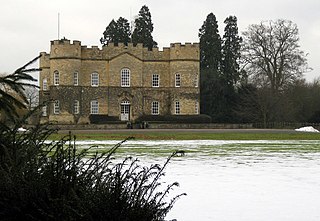
Bracebridge Heath is a village and civil parish in the North Kesteven district of Lincolnshire, England. It is 2 miles (3 km) south of Lincoln and straddles the border with the Lincoln and North Kesteven district boundaries.

Burwell is a small village and Civil parish in the East Lindsey district of Lincolnshire, England. It is situated on the A16 road, and north from Spilsby. The village covers approximately 2,200 acres (8.9 km2).

Welton is a large village and civil parish in the West Lindsey district of Lincolnshire, England. The population of the civil parish was recorded as 4,327 in the 2011 census. It is geographically situated 6 miles (9.7 km) north from Lincoln. The name Welton by Lincoln is also used to distinguish from other similarly named villages in Lincolnshire: Welton le Wold and Welton le Marsh.

Addlethorpe is a small village situated just off the A52 west of Ingoldmells in the East Lindsey district of Lincolnshire, England.

Authorpe is a village and civil parish in the East Lindsey district of Lincolnshire, England. It is situated between the A16 and the A157 roads, 6 miles (10 km) south-east from Louth and 4.5 miles (7 km) north-west from Alford.

Partney is a small village and civil parish in the East Lindsey district of Lincolnshire, England. It is situated 3 miles (4.8 km) north of Spilsby, and in the Lincolnshire Wolds. The village was the birthplace of Henry Stubbe, the noted 17th-century Intellectual.

Fillingham is a village and civil parish in the West Lindsey district of Lincolnshire, England. It is situated 9 miles (14.5 km) north from the city and county town of Lincoln, and just over 1 mile (1.6 km) west from the A15 road.

Goltho is a hamlet in the West Lindsey district of Lincolnshire, England. The population was 157 at the 2011 census. It is situated 1 mile (1.6 km) south-west from Wragby, and 0.5 miles (0.8 km) south from the A158 road.

Wainfleet St Mary is a village and civil parish in the East Lindsey district of Lincolnshire, England. It is situated directly south of Wainfleet All Saints on the A52 road, 5 miles (8 km) south-west from Skegness and 14 miles (23 km) north-east from Boston. The 2001 Census recorded a population of 1,106, reducing to 1,025 at the 2011 census. It includes the hamlet of Wainfleet Bank.

St Michael's Church is a redundant Anglican church in the hamlet of Buslingthorpe, Lincolnshire, England. It is recorded in the National Heritage List for England as a designated Grade II* listed building, and is under the care of the Churches Conservation Trust. It stands in an isolated position adjacent to a partly moated farm to the east of the A46 road. The church is notable for two mediaeval monuments to members of the Buslingthorpe family.

Claxby St Andrew, is a village and civil parish about 3 miles (5 km) south of Alford, in the East Lindsey district of Lincolnshire, England. In 2021 the parish had a population of 43.

Great Steeping is a village and civil parish in the East Lindsey district of Lincolnshire, England. It is situated approximately 3 miles (5 km) from Spilsby. The parish includes the hamlet of Monksthorpe.

Haltham is a village and civil parish in the East Lindsey district of Lincolnshire, England. The population of the civil parish at the 2011 census was 122. It is situated 4 miles (6.4 km) south from the town of Horncastle, and on the east bank of the River Bain in the Lincolnshire Wolds, a designated Area of Outstanding Natural Beauty.

Market Stainton is a village and civil parish in the East Lindsey district of Lincolnshire, England. It is situated approximately 7 miles (11 km) north from the market town of Horncastle.

South Reston is a village in the civil parish of Reston, in the East Lindsey district of Lincolnshire, England. It is situated on the A157 road 5 miles (8.0 km) south-east from the town of Louth.

North Ormsby is a village and civil parish in the East Lindsey district of Lincolnshire, England. It is situated approximately 7 miles (11 km) north-west from the market town of Louth.

The Church of St John the Evangelist is a Grade I listed Church of England parish church dedicated to John the Evangelist, in Corby Glen, Lincolnshire, England. The church is 9 miles (14 km) south-east of Grantham, and in the South Kesteven Lincolnshire Vales. It is noted in particular for its 14th- and 15th-century medieval wall paintings.

St Katherine's Church, Lincoln also known as "Southside" and "St Katherines Cathedral Church" is a Grade II-listed church in Lincoln, Lincolnshire, England. It is a former Methodist church in the Boultham and St Catherine's areas of the city. It was first opened in 1887 with the tower and spire being added later. During its use as a place of worship, it was dubbed "Lincoln's second cathedral.

Baptist Chapel, Lincoln is a Baptist Chapel on Mint Lane/Mint Street in Lincoln City Centre in Lincolnshire, England. It is a former Baptist Church and was originally built in 1870 and had a Sunday School attached. It was declared redundant in 1980 and was closed that same year. The chapel and Sunday school are now in use for an estate agents. The chapel is in a conservation area. The 1897 Sunday school building is grade II listed, along with its boundary wall.

St George's Church was a medieval parish church in the city of Lincoln in Lincolnshire, England. It was built around 1100 and served as one of the many parish churches for the city and surrounding area until 1499, when it was demolished. The site of the church and churchyard is now under a car park and partly occupied by the Lincoln Museum.























